Beautiful handwriting is an art that needs regular practice. As we spend more time at the keyboard, our handwriting suffers. But its possible to improve and there are a lot of benefits to improving your handwriting skills.
I noticed that as I spent more and more time at the keyboard writing books, writing blog posts, and social media posts, my personal handwriting got more and more illegible. Maybe you can identify with that.
In fact in 2022 I wrote two books for a commercial publisher all on my keyboard and I completely stopped handwriting in my journal. As we came to December, I realized that my hands no longer felt comfortable writing with a pen. The pen felt clumsy. The letters were no longer well formed. While, I’d never call my handwriting beautiful, it wasn’t even legible. Have you ever experienced that?
If you have you aren’t alone. Many people haven’t written in cursive since grade school. But that’s a terrible loss. There are many benefits to beautiful handwriting beside being happy and satisfied with your writing style.
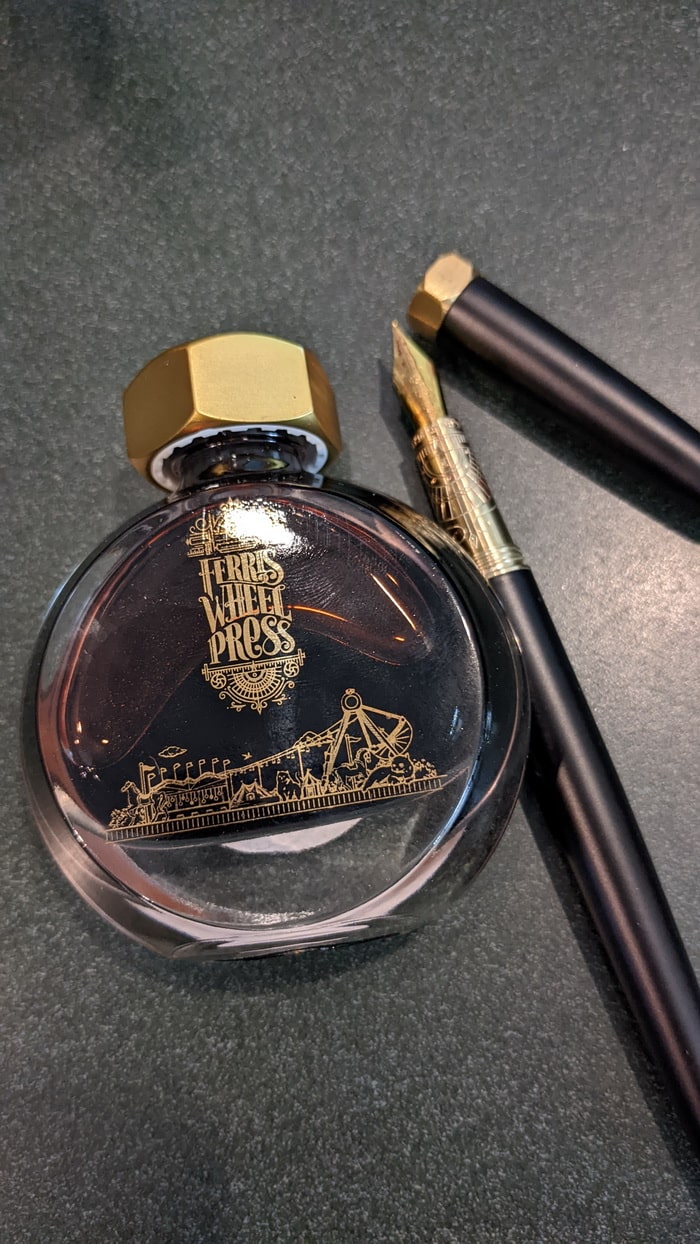
Handwriting for Self Improvement
One of my intentions in 2023 is to improve my penmanship and enjoy handwriting again. Beautiful handwriting is within reach with practice. In fact, handwriting is one area of self-improvement that is within reach for most people.
There are a lot of scientific reasons to reengage with handwriting. Scientists found that students that wrote with a pen or drew with a pen, engage the part of the brain that is used for memory and learning, while writing with a keyboard did not engage these centers of the brain.
Handwriting skills also develop the neuropathways for language development, thinking, and literacy. Research showed that these brain synapses are already well developed by age 8 so the earlier handwriting instruction starts the better.
While most of the research has been done with school children, adults can also benefit from handwriting and penmanship. Stroke patients that had therapy that involved handwriting, improved in memory and brain function faster than those who didn’t have handwriting as part of their therapy.
Handwriting boosts creativity and improves self expression.
It relieves stress and anxiety by helping you work through problems and road blocks.
Handwriting, especially journal writing, improves sleep quality.
It increases concentration and eliminates distractions.
It relieves depression and lifts mood. Some people even say that handwriting changes their lives for the better.
Handwriting as Self-Reliance
As a homesteader though, I want to remind you of a few other benefits of handwriting that many overlook.
- Handwriting is self-reliant and off grid. You don’t need electricity or an internet connection to write with a pen.
- Big Brother can see what you write online — even private messages are being censored now, but he can’t read your handwriting. (Big brother might not be the only one.)
- Handwriting is a technology that can be read even if technology changes and the disc or thumb drive become obsolete. My husband has his Dad’s journals from almost 100 years ago, written in fountain pen, and he often reads them in the evening, to discover what his Dad was doing as a 22 year old lad, newly immigrated to Edmonton from Carluke, Scotland.
- Winston, in the novel, 1984, outsmarted Big Brother by writing in a journal, which was illegal. Handwriting is freedom from surveillance and increased privacy.
- Handwriting can be done anywhere – indoors, outdoors, in a field of wild flowers, hiking on a remote trail, on a camping trip, on the beach, or at an off grid cabin. You just need a pen with ink and paper.
- Handwriting helps you process divergent ideas, emotions, and aids problem solving. Since it engages different centers in the brain than writing on a keyboard, it can help you reach different solutions.
- Your handwriting is unique to you and protected by law from forgery. In the age of deep fakes, and counterfeits, your handwriting is a protected form of communication.
- Beautiful handwriting sets an example for your children to inspire them to write well. Artist and Master Penman Jake Weidmann tells of his mother’s beautiful handwriting which inspired him to improve his writing and become a Master Penman, one of only 9 in the world today.
If you find that writing with a ball point pen cramps your hand and contributes to writer’s cramp or hand fatigue, changing your pen can help. Fountain pens are more ergonomic and can help you write for longer periods with less fatigue.
Your Personal Script
Cursive writing is fluid writing that flows in a single line across the page. Cursive handwriting also increases the flow of thought. Students who wrote the essay portion of their SAT exam using cursive instead of printing scored higher than students that printed their essays. The smooth, flowing letter forms of cursive allowed their thoughts to connect as they wrote. If you learned cursive in school, cursive handwriting is a good script for everyday writing.
However, if you grew up in UK you might have learned Italic handwriting. Italic script was the papal script used for manuscript copy work for centuries. It was taught in English schools and some Canadian schools in the 1960s. Italic script offers beautiful lettering, too. Many people learn Italic letterforms in calligraphy class. But its also a style of writing, sometimes called “cursive italics”. I learned Italic handwriting in grade 5 using an Osmiroid 75 School Fountain Pen, with a gold plated italic nib and India Ink.
Spencerian script is another beautiful lettering form with ornate swirls and loops. It is based on the Copperplate script and was used extensively in business correspondence in the USA before the typewriter. Adapted around 1840, Spencerian script relied on the flexible nib of the fountain pen for its thick and thin strokes that added contrast and depth to the writing style. Spencerian script is held up as the most beautiful handwriting.
Ball and stick cursive handwriting, also called the Zaner-Bloser Method, was adapted in schools when the ball point pen became widely available in the 1960s. Each of these writing styles: Cursive writing, Italic handwriting, and Spencerian script was dependent on using the right pen for the job.
Beautiful Handwriting is a trifecta of the writing tool, the paper, and the ink. Let’s look at the most common writing tools, beautiful paper, and quality inks that are available today.
The Tools
Ball point pens
Ball point pens became popular in the 1960s when Bic came out with their 19 cent disposable pen. Ball point pens use an oil based ink that doesn’t dry out. 10 billion disposable ballpoint pens are thrown away every year worldwide. However, there are ball point pens like The Pilot Metropolitan that use refills, reducing some of the waste of disposable pens. The average ball point pen will write 100 pages before running out of ink. Your ink choices are limited to blue, black, and red.
Gel pens
Gel pens write with less friction than ball point pens and are easier on the hand for long writing sessions. They use a paste ink that flows freely from the felt tip. Some gel pens, like the Pilot Metropolitan use refills to extend the life of the pen. Some gel pens are available with ink converters that use fountain pen inks, reducing waste. Gel pens are available in a wide range of colors. The average gel pen will write 40 pages before running out of ink.
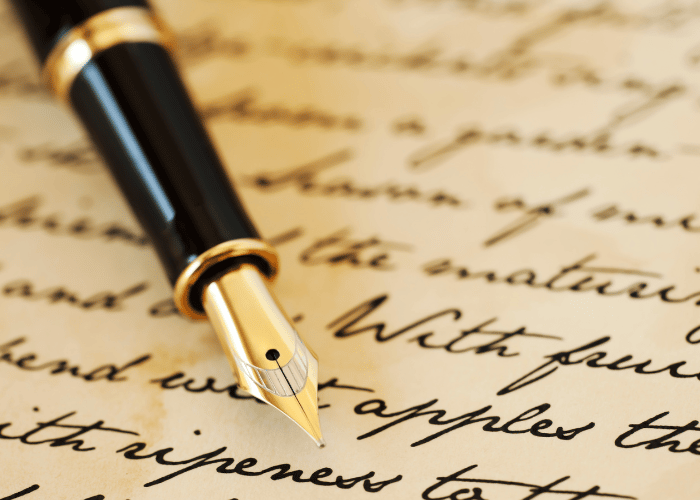
Fountain pens
Fountain pens use water based ink. They write smoothly without drag on the page and are the easiest pens to write with for long writing sessions. Because the ink comes to the nib more slowly than with a ball point, writers need to slow down slightly, improving their hand writing quality. Many fountain pen users say that writing with a fountain pen slows down their writing enough to allow them to think more clearly as they write.
In many countries fountain pens are the pen of choice for learning handwriting in school. Inexpensive fountain pens can be had for under $20 and a quality one for under $50. A fountain pen with a 1ml ink converter will write 20 pages before it needs refilling, while a bottle of ink can refill it 50 to 75 times. (That’s 1000 pages or more) Fountain pen inks come in a wide variety of colors including sheen and shimmer inks for wider creative expression.
Fountain pens come in a wide variety of nibs from extra fine, fine, fine medium, medium, broad, stub or Italic, and more. Medium and broad nibs use more ink and are ideal for using shimmer inks to showcase the nuances of color and shimmer. Stub nibs are flat and used in calligraphy and Italic writing to give more line variation. Extra fine and fine are drier nibs that give a controlled writing experience while conserving ink.
One of my favorite and reasonably priced fountain pens is the Pilot Metropolitan or Pilot MR Animal Collection or Pilot MR pop collection or Pilot Cocoon (the Japanese version of the same pen). These are essentially the same pen with different colors and decorations on the outside of the pen. Pilot, a Japanese pen and ink manufacturer brought these out in 2018 for their 100th anniversary and they are exceptionally well made brass pens with painted bodies and steel nibs. This was the first fountain pen I bought since my school days and I have a few of them now. The price on Amazon varies widely but they are generally under $30, depending on the seller.
You’ll want to pick up an ink converter when you get your new fountain pen, if the pen doesn’t come with one. The ink converter allows you to use bottled inks instead of ink cartridges. The above Pilot pens take the Pilot Con40 converter. Some fountain pens are sold with a converter, so check the description of the pen you are interested in. There are other really good quality starter pens but I only have the Pilot pens. Since fountain pens are still used extensively in Europe to teach handwriting skills there are several European made entry level fountain pens to choose from.
Dip pens
Dip pens use water based ink or pigment based calligraphy ink. All fountain pen inks can be used with a dip pen. They are used for drawing, lettering, and calligraphy, as well as handwriting. Dip pens were the early pens and were used for centuries before the pens with internal reservoirs for ink (ie. fountain pens) became common in the 1880s. They are still used today by artists, calligraphers, and those who make their own inks. See this post to learn how to make walnut ink from natural dye.
Glass dip pens are works of art used for writing, calligraphy, and sumi-e, a Japanese pen drawing artform. Calligraphy dip pens use a pen holder with interchangeable nibs giving variation to the pen stroke. Dip pens hold a small amount of ink in the nib reservoir but need to be replenished by dipping every few lines. There is a skill to using a dip pen without dripping the ink.
Paper
Paper is also important to the quality of your handwriting. If you find your hands cramping when you write try changing your paper to a smoother paper, that lets the ink sit on the surface of the page. This can reduce the friction and fatigue with long writing. Textured papers can increase the friction between pen and paper leading to increased fatigue. Highly absorbent paper also uses ink faster, reducing the efficiency of the pen.
Smoother paper such as laser jet paper, Tomoe River paper, Clairefontaine Triomphe notebooks, or Rhodia notebooks work well with both gel pens and fountain pens. Look for a paper that won’t bleed through with the pens and ink you want to use. 90 gram or higher paper usually meets this criterion. I’ve also had success with Hemlock and Oak bound journals (made in Vancouver) which come in bullet journal or graph journal pages.
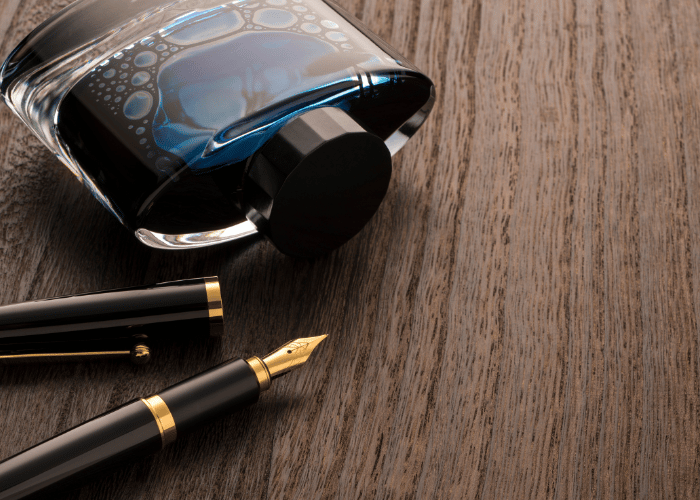
Ink
Fountain pens and some gel pens allow you to change inks using an ink converter. In the last 10 years the choice of quality ink has expanded. There are many choices for every budget, from inexpensive inks that come in 500 ml, bottles to specialty inks with sheen and shimmer that are packaged like fine perfume. Some of my favorite inks are made in France by J. Herbin and use natural dyes as the color pigment, although most fountain pen inks use chemical aniline dyes for color.
Fountain pen enthusiasts often collect both pens and inks as a hobby. Ink samples of many inks are available in 2 to 5 ml bottles for a few dollars, allowing you to sample a wide variety of inks for a few dollars, before you invest in a full bottle.
Beautiful handwriting is complemented with lovely ink colors that speak to you of nature, the garden, the seaside, or the forest. The Pilot Irushizuku inks, made in Japan, are premium inks that behave well in fountain pens and dip pens. These high quality inks come in a wide range of colors and are named in Japanese for objects in the natural world.
Shimmer inks are specialty inks that have reflective oxides added to shimmer in the light. These particles can be difficult to clean from the pen feed, so should be avoided in pens that have integrated ink filler systems like piston fillers and vacuum fillers. But they enhance beautiful handwriting, especially when used with a medium or broad nib, that allows more ink flow when you write. Canadian ink company Ferris Wheel Press has a full range of shimmer inks and limited edition inks that are made in Canada.
India ink, a carbon pigment based black ink, is used with dip pens and brush drawing. It is a permanent ink. It used to be used for legal documents and accounting, but should not be used in today’s fountain pens because it will clog the feeds, and may damage the pen.
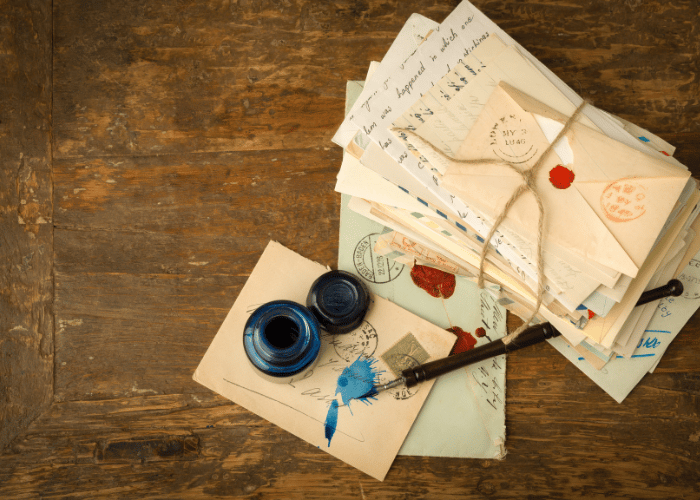
What should you write?
Handwritten notes are rare now. Most people just send a text. But for that reason a handwritten note is a treasure. If a letter seems like too much a postcard might be just the right size. I send postcards to my granddaughters regularly.
- Write a letter to your congressman, mayor, or representative and offer your opinion. Handwritten letters have more weight than petitions in politics.
- Write a thank you note to someone that blessed you.
- Write in a journal and bypass the surveillance state.
- Keep a handwritten to-do list, agenda, or planner.
- Write inspiring quotes or Bible verses
- Write study notes, recipes, or ideas.
- Copy poetry into your handwriting practice book
- Write your prayers. It can help you focus.
- Write a story about your life for your grandchildren
- Keep a garden journal and write daily posts about the weather and the garden
- Improve your handwriting by doing copywork in a handwriting book
Improving your handwriting is a targeted way to self improvement. Beautiful handwriting has many benefits including improvement of thinking and reasoning skills, problem solving, memory, communication skills, and learning. It is also private and outside the surveillance state. You can start right now.



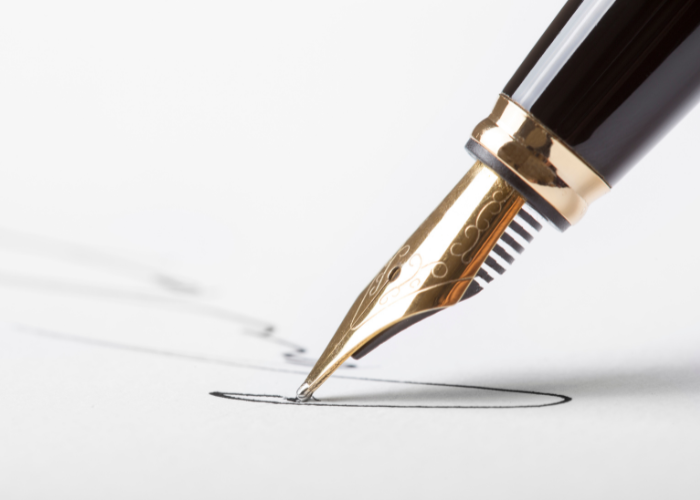

Leave a Reply